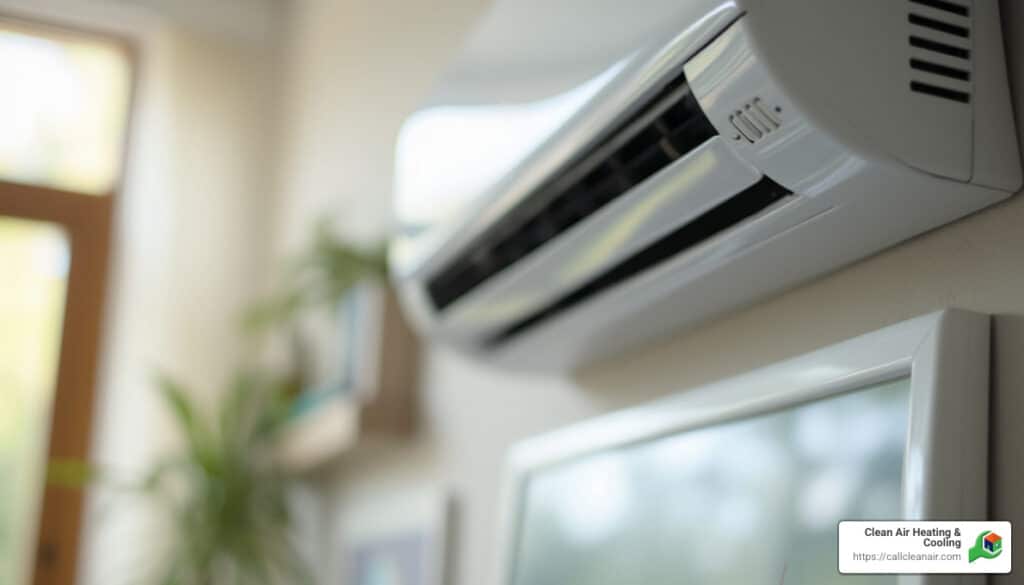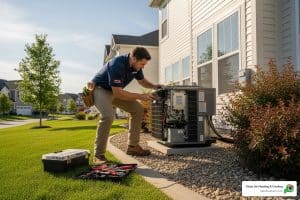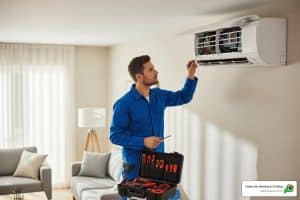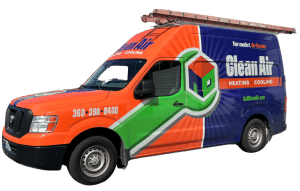Mini split maintenance is crucial to ensure your system runs efficiently, keeping your home comfortable year-round. By investing a bit of your time each month, you can significantly extend the life of your unit. Here’s a quick guide:
- Clean or replace filters: This should be done monthly for optimal air flow and energy efficiency.
- Wipe down condenser coils: Regular cleaning prevents damage and maintains system performance.
- Clear pipes: Remove any obstructions to ensure effective temperature control.
Maintaining your mini-split system well not only lowers energy bills but also improves indoor air quality, enhancing the comfort of your living space. Regular maintenance prevents costly repairs and extends the lifespan of your system.
I’m Colin Matei, owner of Clean Air Heating & Cooling. With a commitment to providing reliable HVAC solutions, I’ve spent years focusing on mini split maintenance to ensure homeowners in Northwest Washington enjoy lasting comfort. Let’s take a closer look at the nuances and techniques involved.

Basic mini split maintenance vocab:
– Cleaning mini split heat pump
– HVAC system checkup
– Split AC cleaning pump
Understanding Your Mini Split System
To master mini split maintenance, you first need to understand the components of your system. A mini split system is made up of two main parts: the indoor unit and the outdoor unit. These components work together to regulate the temperature in your home efficiently.
Components
- Indoor Unit: This is the part you interact with most. It’s the air handler that cools or heats your room. It’s usually mounted on a wall, floor, or ceiling, depending on your space needs. The indoor unit houses the evaporator coil and the air filter. It’s responsible for blowing the conditioned air into your room.
- Outdoor Unit: Often referred to as the heat pump, this component is placed outside your home. It contains the compressor and condenser coil. This unit takes air from outside, either heating or cooling it, before sending it to the indoor unit.
- Connecting Lines: The indoor and outdoor units are connected by refrigerant lines, suction lines, and power lines. These small lines are crucial for transferring the refrigerant and electricity between the units, making the system ductless and more energy-efficient.
Air Circulation
Air circulation is vital for your mini split system to function correctly. The system pulls air from the room, conditions it, and then circulates it back. This process helps maintain a consistent temperature and improves air quality.
To ensure effective air circulation:
- Clear Space Around Units: Make sure there’s enough space around both the indoor and outdoor units. This prevents obstruction and allows for smooth airflow. Keep furniture and decorations at least four feet away from the indoor unit.
- Clean Filters Regularly: Dirty filters can block airflow, reducing efficiency and air quality. Clean or replace them monthly to keep the system running smoothly.
- Inspect the Outdoor Unit: Remove any debris, ice, or snow that may accumulate on the outdoor unit, especially during colder months. This helps prevent damage and maintains airflow.
By understanding the basic components and ensuring proper air circulation, you can maximize the efficiency and longevity of your mini split system. Now that you have a grasp of the system’s structure, let’s dig into the essential maintenance tasks to keep it operating at its best.
Essential Mini Split Maintenance Tasks
Maintaining your mini split system is key to ensuring it runs efficiently and lasts longer. Let’s explore the essential mini split maintenance tasks you can perform to keep your system in top shape.
Cleaning and Changing Filters
Regularly cleaning and changing the air filters is one of the simplest yet most effective maintenance tasks. Clean filters improve air quality and energy efficiency by ensuring smooth airflow.
Frequency: Aim to clean or replace your filters once a month, especially during periods of heavy use. This frequency helps prevent dust buildup that can clog the system and reduce its efficiency.
Method:
1. Turn off the system to ensure safety.
2. Open the cabinet door of the indoor unit.
3. Slide out the filters carefully, noting their original position.
4. Clean the filters using a light vacuum or as per the manufacturer’s instructions.
5. Reinstall the filters in their original position and close the cabinet door.

Wiping Down Condenser Coils
The condenser coils, located in the outdoor unit, are vital for heat exchange. Keeping them clean prevents mold and mildew from affecting the system’s performance.
Location: The condenser coils are in the outdoor unit, which is usually placed on a flat surface outside your home.
Method:
1. Turn off power to the system.
2. Use a coil cleaning solution and a soft brush to gently clean the coils.
3. Rinse with a light spray of water, avoiding high pressure.
Professional Help: If you’re unsure about cleaning the coils or notice excessive buildup, consider hiring a professional to ensure a thorough job.
Clearing the Pipes
Clearing the connecting pipes of your mini split system helps prevent leaks and ensures efficient refrigerant flow.
Importance: Blocked or leaking pipes can reduce system efficiency and cause potential damage.
Method:
1. Inspect the pipes for any visible blockages or damage.
2. Use a pipe cleaner or a soft brush to clear any debris.
3. Check for leaks regularly, especially at connection points.
Cleaning the Exterior
Keeping the exterior of both the indoor and outdoor units clean prevents dust and debris from entering the system and causing internal damage.
Dust and Debris: Dust can accumulate on the exterior, leading to potential blockages and reduced efficiency.
Method:
1. Wipe down the exterior of both units with a damp cloth.
2. Ensure the outdoor unit is free from leaves, snow, or ice, particularly during seasonal changes.
By performing these essential maintenance tasks, you can ensure your mini split system operates efficiently and provides a comfortable indoor environment. Next, we’ll explore the benefits of professional mini split maintenance and when it’s time to call in the experts.
Professional Mini Split Maintenance
While regular DIY maintenance is crucial, there are times when professional expertise is essential to keep your mini split system running smoothly. Understanding what to expect from a professional service can help you make informed decisions about your system’s care.
What to Expect from a Professional Service
When you schedule a professional mini split maintenance service, you’re investing in the longevity and efficiency of your system. Here’s what a typical service might include:
- Annual Inspection: An HVAC technician will conduct a thorough inspection of your mini split system. This includes checking all components for wear and tear, ensuring everything is in working order.
- Deep Cleaning: Professionals use specialized tools and cleaning solutions to reach areas that are difficult to clean on your own, like the evaporator and condenser coils. This deep cleaning helps prevent mold and mildew buildup.
- Parts Replacement: If any parts are worn out or broken, a technician can replace them before they cause more significant issues. This proactive approach saves you from unexpected breakdowns.
- Refrigerant Check: Technicians will check refrigerant levels and look for leaks. Maintaining the correct refrigerant level is vital for optimal cooling performance.
- Troubleshooting: If your system has been showing signs of trouble, such as unusual noises or reduced airflow, a professional can diagnose and fix these issues during the visit.
Benefits of Professional Maintenance
Opting for professional maintenance offers several advantages:
- Efficiency: A well-maintained system runs more efficiently, reducing energy consumption and lowering your utility bills.
- Longevity: Regular professional care extends the life of your mini split, delaying the need for costly replacements.
- Cost Savings: By addressing small issues before they escalate, you can avoid major repairs that can be expensive and disruptive.
- Avoiding Major Repairs: Regular check-ups help catch potential problems early, reducing the risk of sudden breakdowns that could leave you without cooling or heating when you need it most.
By investing in professional maintenance, you’re not only ensuring your mini split system operates at its best but also safeguarding your comfort and peace of mind. Next, we’ll discuss some DIY mini split maintenance tips and when it might be time to call in the experts.
DIY Mini Split Maintenance Tips
Taking care of your mini split system at home can be simple and effective. Here are some DIY mini split maintenance tips to keep your system in top shape.
Safety Precautions
Before you start any maintenance tasks, safety is crucial. Always turn off the power to your mini split system to avoid electric shock. Use proper tools designed for HVAC maintenance. If you’re unsure about any step, it’s better to seek professional help.
Basic DIY Tasks
Keeping your mini split clean is key to its performance. Here are some basic tasks you can handle:
- Cleaning Filters: Dirty filters reduce airflow and efficiency. Every 4-6 weeks, remove and clean the filters with a light vacuum or as recommended by the manufacturer. This simple task can improve air quality and save energy.
- Wiping Down Coils: Dust and dirt can accumulate on the coils, affecting performance. With the power off, gently wipe the coils with a dry cloth. This prevents mold and mildew buildup, which can harm your system.
- Clearing Debris: Check the outdoor unit for leaves, twigs, or other debris. Keeping the area clear ensures proper airflow and prevents internal damage.
When to Call a Professional
While DIY maintenance covers the basics, some issues require expert attention:
- Complex Issues: If you notice excessive condensation, ice buildup, or signs of water leakage, it’s time for a professional. These could indicate deeper problems that need specialized tools and expertise.
- Refrigerant Leaks: Low refrigerant levels or icy coils might signal a leak. Only a certified technician should handle refrigerants safely and effectively.
- Unusual Noises: New or strange sounds from your mini split aren’t normal. They could be a sign of mechanical issues that need prompt attention to avoid further damage.
By performing regular DIY maintenance, you can keep your mini split system running efficiently. However, knowing when to call a professional ensures that complex problems are addressed correctly, safeguarding your investment.
In the next section, we’ll explore frequently asked questions about mini split maintenance to further improve your understanding.
Frequently Asked Questions about Mini Split Maintenance
What maintenance is required on a mini split?
Mini split maintenance is essential for keeping your system efficient and reliable. Regular maintenance tasks include cleaning the filters, wiping down the coils, and clearing any debris around the outdoor condenser. These tasks help ensure that your system runs smoothly and efficiently.
- Clean Filters: To maintain good airflow and energy efficiency, clean the filters every 4-6 weeks. This involves removing the filters and using a light vacuum or following the manufacturer’s cleaning instructions.
- Wipe Coils: The coils can gather dust and dirt, which can impact performance. Gently wipe them down with a dry cloth to prevent mold and mildew buildup.
- Clear Pipes: Check the pipes for any blockages or leaks. Keeping them clear ensures that the system operates effectively and prevents potential water damage.
- Clean Exterior: Dust and debris can accumulate on the exterior of the unit. Wipe it down regularly to prevent particles from entering the system and causing internal damage.
Are mini splits hard to maintain?
Mini splits are generally easy to maintain, especially when compared to traditional HVAC systems. Regular cleaning and inspection tasks are simple and can be done by most homeowners. However, some issues, like refrigerant leaks or complex mechanical problems, should be handled by an HVAC technician.
- Efficiency: Regular maintenance keeps your mini split running efficiently. It helps in reducing energy consumption and prolonging the system’s lifespan.
- Ease of Maintenance: With no ductwork to worry about, mini splits require less maintenance than central air systems. Basic cleaning tasks are straightforward and can significantly impact performance.
How to maintain your mini split?
To maintain your mini split, focus on regular cleaning and inspection. This approach not only keeps your system efficient but also helps in identifying potential issues early on.
- Clean Filters: Regularly cleaning the filters improves air quality and system efficiency. This simple step can prevent many common issues associated with mini splits.
- Wipe Coils: Keeping the coils clean prevents efficiency drops and extends the system’s life. It’s a quick task that can be done during your regular maintenance routine.
- Clear Pipes: Ensure that the pipes are free from blockages and leaks. This will help avoid water damage and maintain system performance.
- Clean Exterior: The exterior of the mini split can gather dust and debris. Regularly wipe it down to protect the internal components from damage.
For more complex maintenance or if you’re unsure about any step, it’s always best to consult with an HVAC technician. They can provide professional insights and services to keep your mini split in top condition.
In the next section, we’ll discuss the benefits of professional maintenance and when it’s necessary to call in the experts.
Conclusion
In summary, regular mini split maintenance is crucial for ensuring your system runs efficiently and lasts for years. Simple tasks like cleaning filters, wiping down coils, and clearing pipes can significantly improve performance and prevent costly repairs. While these tasks are manageable for most homeowners, more complex issues should be left to the professionals.
At Clean Air Heating & Cooling, we understand the importance of keeping your mini split system in top condition. Our team of expert HVAC technicians is ready to assist with thorough inspections, detailed cleanings, and any necessary repairs. We pride ourselves on providing prompt, high-quality service to our customers in Northwest Washington, including Whatcom, Skagit, Snohomish, and San Juan Counties.
Regular maintenance not only improves the efficiency and longevity of your mini split system but also offers peace of mind, knowing your home will stay comfortable year-round. Trust Clean Air Heating & Cooling to help you master mini split maintenance for optimal performance.
For more information or to schedule a service, contact us today. With over 480 5-star Google reviews and a 25% utility savings guarantee, we are committed to delivering exceptional customer satisfaction.





